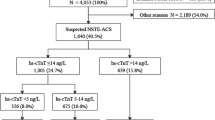Abstract
Background
Cardiac troponins are the preferred biomarkers to predict infarct size in patients (pts) after acute myocardial infarction (AMI). Less information is currently available to verify the prognostic value of such a biomarker surrogate.
Methods
We included 82 pts with acute STEMI and compared all single time point and serial cardiac troponin T (cTnT) values (peak and area-under-the-curve) from admission until day 4 to predict future major adverse cardiac events (MACE).
Results
Pts who had suffered any MACE during follow-up had higher cTnT values (median (25th/75th percentiles) on day 4 (3.16 µg/l (2.71/5.20) Vs. 2.1 µg/l (1.19/3.96), P = 0.0304), and higher peak cTnT values (5.11 µg/l (3.31/9.47) Vs. 2.92 µg/l (1.81/5.63), P = 0.0234). The likelihood to develop a composite of MACE was twofold higher in the intermediate cTnT tertile (1.66–3.04 µg/l, n = 23), and in the upper cTnT tertile (3.35–20.68 µg/l, n = 23) for cTnT on day 4. For cTnT peak the risk was 1.7-fold higher in the intermediate cTnT peak tertile (2.55–5.01 µg/l, n = 28) and 2.4-fold in the upper cTnT peak tertile (5.11–18.93 µg/l, n = 27). The optimal ROC cutoff for cTnT to predict the composite of MACE was 2.69 µg/l measured on day 4 and 2.85 µg/l for the cTnT peak.
Conclusions
A single measurement of cTnT after STEMI is an independent predictor for MACE, performs as effective as serial cTnT sampling and may be useful to assess future events.




Similar content being viewed by others
References
Gallegos RP, Swingen C, XU XJ et al (2004) Infarct extent by MRI correlates with peak serum troponin level in the canine model. J Surg Res 120:266–271
Giannitsis E, Steen H, Kurz K et al (2008) Cardiac magnetic resonance imaging study for quantification of infarct size comparing directly serial versus single time-point measurements of cardiac troponin T. J Am Coll Cardiol 51:307–314
Ingkarnison WP, Rhoads KL, Aletras AH et al (2004) Gadolinium-enhanced delayed enhancement carciovascular magnetic resonance correlates with clinical measures of myocardial infarction. J Am Coll Cardiol 43:2253–2259.
Katus HA, Remppis A, Neumann FJ et al (1991) Diagnostic efficiency of troponin T measurements in acute myocardial infarction. Circulation 83:902–912
Kurowski V, Giannitsis E, Killermann DP et al (2007) The effects of facilitated primary PCI by guide wire on procedural and clinical outcomes in acute ST-segment elevation myocardial infarction. Clin Res Cardiol 96:557–565
Larose E, Ganz P, Reynolds HG et al (2007) Right ventricular dysfunction assessed by cardiovascular magnetic resonance imaging predicts poor prognosis late after myocardial infarction. J Am Coll Cardiol 49:855–862
Lehrke S, Giannitsis E, Katus HA (2004) Admission troponin T, advanced age and male gender identify patients with improved myocardial tissue perfusion after abciximab administration for ST-segment elevation myocardial infarction. Thromb Haemost 92:1214–1220
Licka M, Zimmermann R, Zehelein J et al (2002) Troponin T concentrations 72 h after myocardial infarction as a serological estimate of infarct size. Heart 87:520–524
Panteghini M, Cuccia C, Bonetti G et al (2002) Single-point cardiac troponin T at coronary care unit discharge after myocardial infarction correlates with infarct size and ejection fraction. Clin Chem 48:1432–1436.
Remppis A, Ehlermann P, Giannitsis E et al (2000) Cardiac troponin T levels at 96 h reflect myocardial infarct size: a pathoanatomical study. Cardiology 93:249–253
Roth HJ, Leithäuser RM, Doppelmayr H, Doppelmayr M, Finkernagel H, von Duvillard SP, Korff S, Katus HA, Giannitsis E, Beneke R (2007) Cardiospecificity of the 3rd generation cardiac troponin T assay during and after a 216 km ultra-endurance marathon run in Death Valley. Clin Res Cardiol 96:359–364
Sakuma T, Hiyashi Y, Sumii K et al (1998) Prediction of short—and intermediate-term prognosis of patients with acute myocardial infarction using myocardial contrast echocardiography one day after recanalization. J Am Coll Cardiol 32:890–897
Steen H, Giannitsis E, Futterer S et al (2006) Cardiac troponin T at 96 h after acute myocardial infarction correlates with infarct size and cardiac function. J Am Coll Cardiol 48:2192–2194
The Multicenter Postinfarction Research Group (1983) Risk stratification and survival after myocardial infarction. N Engl J Med 309:331–336
Wu K, Zerhouni EA Judd RM et al (1998) Prognostic significance of microvascular obstruction by magnetic resonance imaging in patients with acute myocardial infarction. Circulation 97:765–772
Younger JF, Plein S, Barth J et al (2007) Troponin-I concentration 72 h after myocardial infarction correlates with infarct size and presence of microvascular obstruction. Heart 93(12):1547–1551
Author information
Authors and Affiliations
Corresponding author
Rights and permissions
About this article
Cite this article
Kurz, K., Schild, C., Isfort, P. et al. Serial and single time-point measurements of cardiac troponin T for prediction of clinical outcomes in patients with acute ST-segment elevation myocardial infarction. Clin Res Cardiol 98, 94–100 (2009). https://doi.org/10.1007/s00392-008-0727-9
Received:
Accepted:
Published:
Issue Date:
DOI: https://doi.org/10.1007/s00392-008-0727-9




